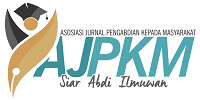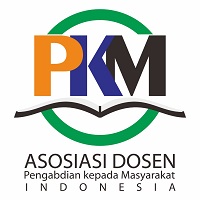Online Submissions
Already have a Username/Password for Reswara: Jurnal Pengabdian Kepada Masyarakat?
Go to Login
Need a Username/Password?
Go to Registration
Registration and login are required to submit items online and to check the status of current submissions.
Author Guidelines
Author Guidelines
A. General Provisions
- Articles are structured reports of community service and empowerment activities that consist of at least a title, abstract, introduction, implementation methods, results and discussion, conclusion, and references. Detailed instructions for preparing articles can be found in the Article Template.
- The submission is an original work, free from any plagiarism, and less than 20% checked by Internet-based plagiarism detection service (Ithenticate/Turnitin).
- The submission has not been published and has not been accepted for publication in other journals.
- The submission is typed in 1,15 spaces using quarto paper (A4); fonts of Century Gothic Size 9; the right and left margins of 2,01cm, top margin of 2,49cm, and bottom margins of 3 cm.
- The submission is typed with one column layout
- The submission is written in English or Indonesia in accordance with general guidelines.
- Enter all of the co-author information/metadata when you submit the manuscript through OJS.
- Use recent references, preferably from scientific journals published within the last 10 years, and use a minimum of 15 references.
- Please download the template to make your article match our guidelines.
- The file size should not exceed 2 MB (.docx).
- The American Psychological Association (APA) 7th edition is highly recommended for use with the Mendeley app.
B. Systematic Writing of Original Article
Title
- The title of the article shall be in Century Gothic, size 16, bold and upright, no more than 15 words, capitalized, and avoid the use of abbreviations. The title of the article must reflect the content of the activity and does not need to include the name of the service location.
- The author's name is in Century Gothic, size 10, bold and upright. The address of the institution and of the author of the correspondence is written in the same font, size 9, normal, with an asterisk. The names of the authors are written immediately below the title, accompanied by the name of the author's institution (program/department, college). Corresponding author is listed below the article history with the author's name and email address.
Abstract
- Abstracts and keywords are written in font Century Gothic, size 8. Indonesian Abstracts are in one paragraph format, printed upright, text alignment using left and right alignment. English Abstract is in one paragraph format, italic.
- The abstract consists of 150–300 words that explain the objectives, brief methods, significant findings, and there should not be any references.
- Keywords are written in English and Indonesia, 3–5 keywords or phrases, arranged alphabetically, and separated using semicolons (;) for author template.
- Please do not use terminologies that are too general, wordy, and lengthy.
- Kindly prevent words that are already used in the title.
Introduction
- The introduction begins with an overview of the target community and an analysis of the situation of the service partners as a whole. Then, it would be better to include a review of previous literature which are published no later than 10 years (what others have done to overcome the same problems, citations are written in the American Psychological Association format). Next, write the ideas/problem solving proposed in this service and conclude with the goals and objectives of the service activity.
- Authors are required to justify the form of the participation and interaction of the communities in the program and activities of the community engagement.
Methods
- Service Location and Target Description: Describe the location of the service activity and the characteristics of the target audience (e.g., a specific community, business group, school, etc.).
- Methods or approaches used: Describe the method chosen, such as workshops, mentoring, training, or applied research. Explain why the method was chosen.
- Stages of Implementation: Describe the steps or stages of the service activity, from preparation to evaluation. Usually accompanied by a schedule or timeline.
- Data Collection Techniques and Tools: If an evaluation is being conducted, explain the data collection techniques used (e.g., interviews, questionnaires, or observations).
- Resources Used: Include the resources used, such as labor, tools, and materials, as well as any financial support or sponsorship.
- Analysis and Evaluation of Activity Results: Describe how the data will be analyzed and how the success of the activity will be evaluated.
Result and Discussion
- Relevant documentation with a focus on community empowerment activities.
- For photos/images: the minimum resolution is 300 dpi with JPEG extensions (.jpg). Use image processing software to check dpi.
- Results must be presented correctly and accompanied by an explanation without reference to the literature. Original and important findings must be stated. Results must be illustrated with numbers or tables if necessary, but must be kept to a minimum. Detailed discussion, speculation, and interpretation of data are not included in the results, but in the discussion section.
- Authors are required to emphasize the analysis of the condition before and after the programs/activities of community engagement are implemented.
- The discussion must interpret the findings expressed in the results obtained with the background of existing knowledge. The discussion must highlight a new perspective. Each assumption must be clearly stated.
- The analysis should be completed with a further discussion on the participation of the community as well as the impacts that are gained by the community. It will be good additional content if the Authors also include the adoption of innovation by the community.
- All tables, figures, photo, and graphs included in this manuscript have to be cited and integrated with analysis and/or its justification/significance with the programs/activities of the community engagement. All tables, figures, photo, and graphs should be relevant with the study.
Conclusion
- Provide conclusions of the discussion.
- Mention the impact and benefits of community empowerment activities.
- Provide advice for further community empowerment.
- Produce new findings of theories, postulates, formulas, principles, methods, models, or prototypes supported by research data.
Acknowledgment
- The acknowledgment list consists of people who provided assistance during community empowerment activities.
- Declaration of Conflict of Interest must be clearly written when you (or your company or sponsor) have a financial, commercial, legal, or professional relationship with another organization, or with people who work with them, which contributed to your research.
- If funding was given through grants from universities, colleges, or other research institutions, stated the name of the institution or organization that provided the funds.
- If there are no funders from a university, college, or other research institution, please include the following sentence: This study did not receive specific grants from funding agencies in the public sector, commercial, or non-profit section.
References
- References are written based on APA (American Psychological Association) 7th Edition format.
- References are listed alphabetically.
- References only list literature that you have quoted in the text.
- Check details of references to actual sources. The author is responsible for the accuracy and completeness of the references.
- Where available, URLs for the references have been provided.
- Avoid using more than 25 and less than 15 references. Highly recommend using 80% journal references and 20% book references. Journal references should be published at least 10 recent years.
- Authors are strongly urged to use a reference manager such as Zotero, Endnote, RefWorks, Reference Manager, or Mendeley to build their bibliography.
C. Ethical Code and Regulation
- Authors are required to ensure that all community engagement activities/programs written in this manuscript are free from any matter related/relevant to ethical code and regulation.
- Authors also need to obtain consent from the participating communities in including/presenting any figures, photos, data, or other information that support the community engagement programs/activities in the manuscript.
- After receiving an acceptance letter, the corresponding Author is required to sign and submit an Ethical Clearance Letter addressed to the Editor-in-Chief according to the template provided in the RJPKM OJS.
Submission Preparation Checklist
As part of the submission process, authors are required to check off their submission's compliance with all of the following items, and submissions may be returned to authors that do not adhere to these guidelines.
The paper has not been previously published and/or is not under consideration for publication in another journal.
Submit files in Microsoft Word document format, not PDF, and follow the Reswara template. File size should not exceed 2 MB.
- Teksnya berjarak/spasi 1,15; menggunakan font 9 jenis Century Gothic; dan semua ilustrasi, gambar, dan tabel ditempatkan di dalam teks pada titik yang sesuai, bukan di akhir. Format tabel menggunakan Open Table
- At least 15 references and 80% are from scientific journals using Mendeley software.
Papers must adhere to the requirements for style and bibliography as outlined in the Writing Guidelines.
The results of the plagiarism check using Turnitin / Ithenticate do not exceed 20%.
Copyright Notice
Copyright and License Statement
Reswara Jurnal Pengabdian kepada Masyarakat is published under the terms of Creative Commons Attribution-Share Alike. According to the license under the Attribution-NonCommercial-ShareAlike 4.0 International
The copyright on each article belongs to the author. Users may freely read, print, copy and distribute the material/work in any form, media or format, provided that the author and Reswara Jurnal Pengabdian Kepada Masyarakat are properly credited or cited. Authors are also allowed to post published articles on other website/database systems.
Authors are allowed to distribute the published article to colleagues, post it on an open website - non-commercial, reuse parts or extracts of the article in other works, and make text & data additions. However, authors are not allowed to send their manuscript to other scientific journals after it has been decided to be reviewed by reviewers at Reswara Jurnal Pengabdian kepada Masyarakat (RJPKM).

Reswara Jurnal Pengabdian kepada Masyarakat is licensed under a Creative Commons Attribution-NonCommercial-ShareAlike 4.0 International.
Privacy Statement
Names and email addresses entered into this journal site will be used exclusively for this journal and will not be used for any other party.
Author Fees
This journal charges the following author fees.
FAST-TRACK REVIEW: 1000000.00 (IDR)
Payment of this fee guarantees that the review process, editorial decision, and author notification will take place within 12 business days. Please contact the editorial office to discuss the process.
This publication fee does not influence the editor's decision to accept or reject the article. If the manuscript is accepted for publication, the author will receive a Letter of Acceptance (LoA) with complete information on how to pay the fee.
Jurnal Reswara offers this optional service to help authors who are in a hurry to publish without compromising on quality. This special route is considered to be the best way to disseminate selected articles to the public.
ARTICLE PUBLICATION: 500000.00 (IDR)
If your submission is accepted for publication, you will be charged an APC (Article Publication Charge) to cover publication costs.
























